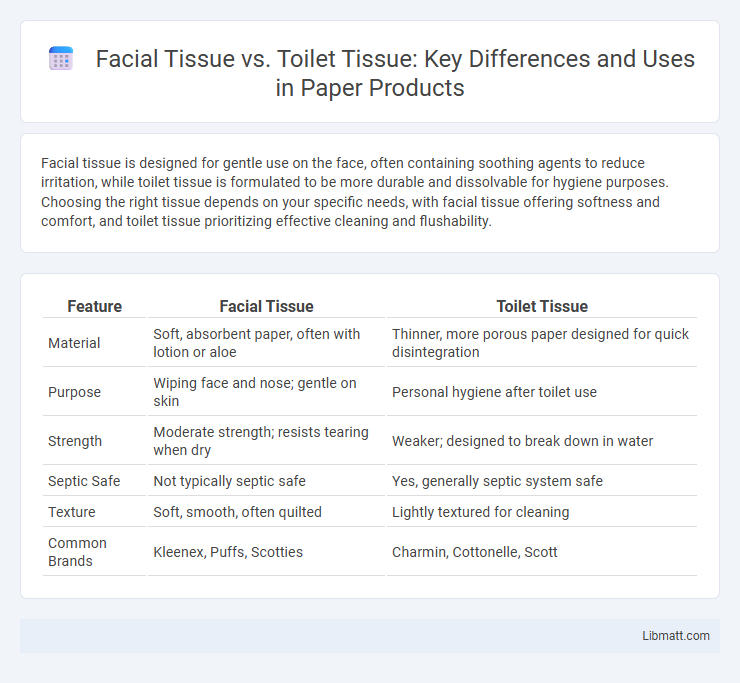Facial tissue is designed for gentle use on the face, often containing soothing agents to reduce irritation, while toilet tissue is formulated to be more durable and dissolvable for hygiene purposes. Choosing the right tissue depends on your specific needs, with facial tissue offering softness and comfort, and toilet tissue prioritizing effective cleaning and flushability.
Table of Comparison
| Feature | Facial Tissue | Toilet Tissue |
|---|---|---|
| Material | Soft, absorbent paper, often with lotion or aloe | Thinner, more porous paper designed for quick disintegration |
| Purpose | Wiping face and nose; gentle on skin | Personal hygiene after toilet use |
| Strength | Moderate strength; resists tearing when dry | Weaker; designed to break down in water |
| Septic Safe | Not typically septic safe | Yes, generally septic system safe |
| Texture | Soft, smooth, often quilted | Lightly textured for cleaning |
| Common Brands | Kleenex, Puffs, Scotties | Charmin, Cottonelle, Scott |
Understanding Facial Tissue and Toilet Tissue
Facial tissue and toilet tissue differ primarily in texture, composition, and purpose. Facial tissue is designed to be soft, gentle, and absorbent to minimize irritation on sensitive facial skin, often containing lotions or soothing additives. Toilet tissue, on the other hand, is engineered for strength, quick disintegration in water, and hygienic disposal, making it suitable for bathroom use.
Key Differences in Composition
Facial tissue and toilet tissue differ primarily in composition, with facial tissue made from finer, softer fibers to minimize skin irritation, often incorporating lotion or aloe for added comfort. Toilet tissue typically uses coarser, more absorbent fibers designed for strength and disintegration in water to prevent plumbing issues. These differences in fiber quality, thickness, and additives directly impact their suitability for delicate facial skin versus bathroom hygiene.
Softness and Comfort Comparison
Facial tissue is specifically designed with extra softness and gentle fibers to minimize irritation on sensitive facial skin, making it ideal for frequent use during colds or allergies. Toilet tissue prioritizes durability and absorbency while maintaining sufficient softness for comfort during use. The difference in ply and material quality results in facial tissue offering superior softness, whereas toilet tissue balances comfort with strength for hygiene purposes.
Absorbency and Strength Analysis
Facial tissue typically features a softer texture with moderate absorbency designed for gentle use on the skin, whereas toilet tissue prioritizes higher absorbency and strength to effectively handle moisture and provide durability during use. The fibers in toilet tissue are often more tightly bonded, enhancing tear resistance compared to the delicate, loosely bonded fibers in facial tissue. When selecting products, understanding this absorbency and strength difference ensures your tissue meets specific hygiene and comfort needs.
Intended Uses and Suitability
Facial tissue is designed for gentle use on delicate skin, making it ideal for blowing noses, removing makeup, or wiping the face without irritation. Toilet tissue, on the other hand, is specifically formulated to be flushable and dissolve quickly in water to prevent plumbing issues, ensuring suitability for personal hygiene after using the restroom. Choosing the right tissue aligns with your needs, as facial tissue prioritizes softness and durability while toilet tissue emphasizes absorbency and safe disposal.
Skin Sensitivity Considerations
Facial tissue is specifically designed for skin sensitivity, using softer fibers and often containing moisturizing agents to minimize irritation, making it suitable for delicate facial skin. Toilet tissue, on the other hand, prioritizes durability and strength over softness, which may cause discomfort or redness for individuals with sensitive skin. Choosing the right tissue for your skin can reduce irritation and improve comfort, especially for those prone to allergies or skin conditions.
Environmental Impact and Sustainability
Facial tissue is often made from virgin fibers, which require more water and energy to produce, whereas toilet tissue frequently incorporates recycled fibers, reducing environmental strain. The biodegradability of both depends on additives and processing, but toilet tissue typically has stricter standards to ensure septic system safety and environmental compatibility. Sustainable options include choosing products certified by organizations like the Forest Stewardship Council (FSC) and opting for tissues with higher recycled content to minimize deforestation and carbon footprint.
Cost Differences and Value
Facial tissue typically costs more per sheet than toilet tissue due to its softer texture and added lotions designed for delicate skin, making it a premium choice for personal care. Toilet tissue is produced in larger volumes with a focus on durability and absorbency, offering better cost efficiency for everyday hygiene needs. Your decision between the two should weigh the higher expense of facial tissue against its specialized benefits versus the economical value of toilet paper for general use.
Packaging and Availability
Facial tissue typically comes in soft, easy-to-access boxes designed for use in living rooms and bedrooms, often available in multi-packs at supermarkets and drugstores. Toilet tissue is usually packaged in larger, cylindrical rolls wrapped in plastic, commonly found in bulk quantities at wholesale clubs and grocery stores. You can easily find both types in various brands, but facial tissue emphasizes convenience and portability, while toilet tissue prioritizes bulk availability and durability.
Choosing the Right Tissue for Your Needs
Facial tissue is designed with softness and gentleness in mind, making it ideal for sensitive skin and frequent use on your face, while toilet tissue is formulated for durability and effective hygiene after bathroom use. Your choice should consider the specific purpose: facial tissue offers superior comfort for wiping noses or removing makeup, whereas toilet tissue provides strength and disintegration appropriate for plumbing systems. Selecting the right tissue ensures optimal functionality, hygiene, and care tailored to your personal needs.
Facial tissue vs toilet tissue Infographic

 libmatt.com
libmatt.com